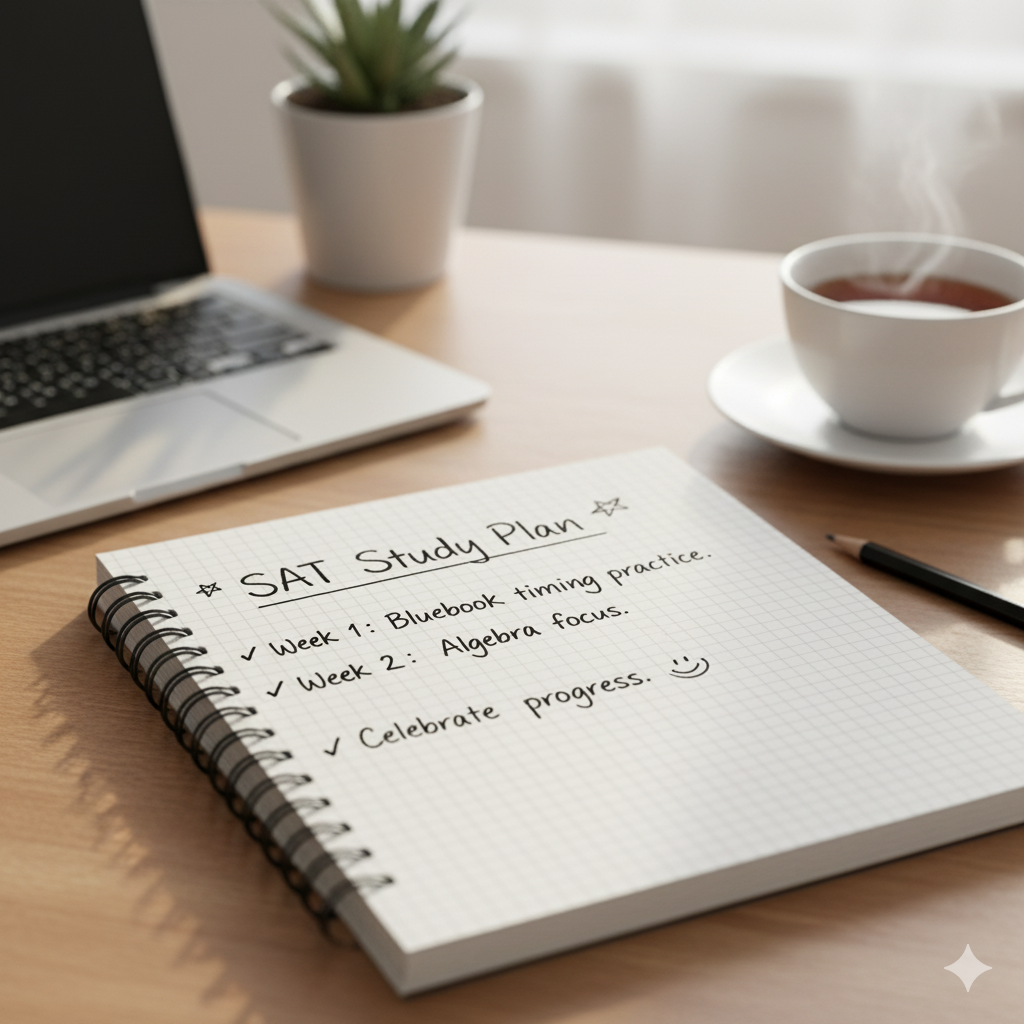When a Practice Score Feels Like a Punch—Take a Breath
You studied. You practiced. You took a full-length Digital SAT practice test on Bluebook or another official platform, clicked submit, and then: your score was lower than you expected. Your stomach tightened. Maybe you wanted to cry, or slam your laptop shut, or convince yourself it doesn’t matter and then immediately worry it does.
First thing: this feeling is normal. A lower-than-expected practice score is not a moral judgment or proof of your future—it’s information. And feelings matter. Before you do anything tactical, allow yourself a real, honest minute to feel disappointed. That tiny pause is what keeps the comeback healthy instead of frantic.
Why Practice Scores Sometimes Stumble
Understanding why a practice score went poorly helps you react constructively, not emotionally. Common reasons include:
- Test-day conditions (fatigue, hunger, distractions).
- Not yet being comfortable with the digital testing environment or Bluebook tools.
- Gaps in specific content (a subset of math topics, reading passages about unfamiliar subjects).
- Poor time management on adaptive sections or unfamiliarity with the new digital format’s pacing.
- Test anxiety or pressure causing careless mistakes.
Framing the score as data—what it tells you about timing, content, and mindset—turns it into a roadmap rather than a verdict.
Step 1: Emotional Triage—Short-Term Care for Your Confidence
When a test drains your confidence, respond like you would to a small physical injury: immediate, kind care to prevent a deeper hurt. Here’s a short, practical checklist:
- Take a break. Walk outside, stretch, or make a snack for 20–30 minutes.
- Talk to someone who listens without judgment—friend, family member, or teacher.
- Write one honest sentence: “I’m disappointed because…” and one hopeful sentence: “I’ll try…”
- Do a quick win: 10 minutes of easy practice (like a few question-of-the-day items) to remind your brain how success feels.
These small moves stabilize emotion so you can return to analysis with clarity.
Step 2: Analyze the Score with Compassion
Once you’re calmer, open your practice test score report. Don’t hunt for confirmation bias—look for patterns.
What to look for in the report
- Section breakdowns: Did one section drag the score down?
- Question types: Were certain question types (data interpretation, command-of-evidence, algebra) repeatedly missed?
- Timing: Were most errors clustered toward the end of a section?
- Careless errors versus conceptual mistakes: Did you misread, miscalculate, or not know the concept?
Write down two things the score confirms (e.g., “I need to practice grid-in math questions”) and two things it doesn’t (e.g., “I still understand algebra basics”). Keep the list short and factual.
Example: Turning a Score Report into Action
Imagine your practice report shows a weak Math: Heart of Algebra subscore and timing problems on the digital adaptive section. Your action looks different than a student whose mistakes are mainly careless reading errors. For the former, schedule targeted algebra practice and concept review. For the latter, practice slow, careful passage reading and annotating on the digital interface.
Step 3: Reset Goals—Make Them Small, Realistic, and Time-Bound
Your long-term goal might be “get into my top-choice college.” That’s important, but it’s too big to hold after a rough practice score. Instead, set micro-goals that are within reach over the next 1–2 weeks and reinforce momentum.
- Short-term goal examples:
- “Improve algebra question accuracy on practice sets from 60% to 75% in two weeks.”
- “Complete two adaptive Bluebook practice sections per week to get comfortable with pacing.”
- “Reduce careless mistakes by reading the question twice before answering, for one week.”
- Schedule check-ins: pick a day each week to review progress and adjust.
Small wins compound—each micro-goal you hit rebuilds confidence and makes the next step easier.
Step 4: Rebuild Your Study Plan Around Your Findings
A practice test is your curriculum compass. Use the patterns you found to rebuild a study plan that’s focused, balanced, and sustainable.
Elements of a resilient study plan
- Targeted Skill Work: 3 short, high-quality practice sessions per week on weak areas (30–50 minutes each).
- Timed Practice: At least one adaptive section simulation per week to practice pacing in the Bluebook environment.
- Review and Reflection: After each practice, spend 20 minutes logging mistakes and writing the correct thinking process.
- Rest and Recharge: A minimum of one full day off from SAT work per week to prevent burnout.
Sample 4-Week Rebuild Plan
| Week | Focus | Weekly Tasks | Mini-Goal |
|---|---|---|---|
| 1 | Foundations & Timing |
|
Comfort using Bluebook tools; reduce random guessing |
| 2 | Targeted Weaknesses |
|
Raise accuracy in weak question types by ~10% |
| 3 | Full-Length Simulation |
|
Maintain pacing; see score improvement on practice test |
| 4 | Polish & Confidence |
|
Enter next practice test with calm, prepared confidence |
Step 5: Practice Smarter—Not Just Longer
Quality beats quantity. Thoughtful practice means deliberate focus on the underlying thinking the SAT demands: interpretation, reasoning, and clear solution paths.
Deliberate practice techniques
- Active error logs: For every wrong answer, write what you thought and what the correct thinking is.
- Chunking: Break larger topics into small concepts (e.g., linear equations → slope interpretation → solving for intercept) and master each chunk.
- Spacing: Spread practice on a topic across days rather than cramming in a single marathon.
- Mixed practice: Rotate between reading, writing, and math in short bursts to mimic the mental switching of the real test.
Also, practice in the same mode you’ll test in: if you’ll use Bluebook on test day, simulate the digital format so the interface becomes second nature.
Step 6: Rework Test-Day Habits to Reduce Anxiety
Anxiety often costs more points than content gaps. Rewriting test-day habits can be a low-effort, high-impact area for immediate improvement.
Pre-test ritual checklist
- Sleep: Aim for 8 hours the night before major practice or test days.
- Nutrition: Balanced breakfast with protein; avoid heavy sugar spikes.
- Warmup: 15–20 minutes of light, low-stakes SAT practice (questions of the day).
- Strategy plan: One page with your pacing targets, small calming cues, and a reminder of the micro-goals you’ve been hitting.
- Device check: If using Bluebook, ensure the device and charger are ready and practice the tools the week before.
Step 7: Use Support—You Don’t Have to Do It Alone
Getting help isn’t a sign of weakness; it’s strategic. Support can be social, academic, or both.
- Study buddies: A friend can keep you accountable and make practice less isolating.
- Teachers or counselors: Ask for targeted feedback on weak areas and realistic expectations.
- Sparkl’s personalized tutoring: If you want 1-on-1 guidance, tailored study plans, expert tutors, and AI-driven insights to accelerate your recovery and target weaknesses, consider a program that adapts to your needs and helps rebuild confidence—especially helpful when the path forward feels unclear.
When looking for help, choose support that fits your learning style: warm encouragement plus concrete skill-building beats vague pep talks.
Step 8: Track Progress with Compassionate Metrics
Score is one metric; learning habits, accuracy on targeted items, and timing consistency matter too. Track a small set of metrics weekly so you can see objective progress:
- Accuracy on targeted question types.
- Average time per question in timed sections.
- Number of careless mistakes per section.
- Number of study sessions completed versus planned.
Use a simple spreadsheet or notebook and log three things after each practice: what went well, what didn’t, and one adjustment for next time.
Progress Tracking Table Example
| Week | Algebra Accuracy | Reading Accuracy | Avg Time/Q | Careless Errors |
|---|---|---|---|---|
| Week 1 | 62% | 70% | 55s | 6 |
| Week 2 | 73% | 72% | 50s | 4 |
| Week 3 | 78% | 75% | 48s | 3 |
Step 9: Re-Test Intelligently—Timing and Mindset
When you feel ready, take another full-length practice test. Don’t rush the retest just to erase a number; schedule it after you’ve completed at least two focused study cycles on your weak areas and had a real simulation of timing and conditions.
- Before retest: review your error log, sleep well, and follow your pre-test ritual.
- After retest: compare the new report to the old one—celebrate concrete improvements, even small ones.
Remember, score swings are normal; what matters is steady improvement and resilience.
Mindset Matters: Reframing Failure as Feedback
The story you tell yourself about a bad practice score determines your reaction. Replace narratives like “I failed” with “I learned something useful.” Reframing turns shame into strategy. Try one of these mental reframes when negativity creeps in:
- From “I’m bad at this” to “I haven’t learned this yet.”
- From “I’m doomed” to “This tells me what to focus on.”
- From “I’m behind” to “I now know the exact gaps to fill.”
Give yourself credit for taking a practice test at all—many students avoid full-length practice precisely because it can highlight areas that need work. You did the brave thing: you found out where to improve.
Self-Care Isn’t Optional
Academic plans are brittle when you’re emotionally depleted. Keep these non-negotiables:
- Sleep hygiene—consistent bedtimes.
- Movement—daily short exercise to clear your head.
- Social time—don’t let SAT prep consume every hour.
- Mindfulness—brief breathing or grounding exercises before heavy practice sessions.
When your brain is rested, it learns faster and remembers better.
When to Ask for More Structured Help
If you’ve tried focused practice for several weeks and your scores don’t budge, or if anxiety consistently blocks performance, it’s time for structured support. Options include school counselors, subject teachers, or tailored tutoring. Personalized tutoring—where a tutor creates a study plan specific to your diagnostics, gives 1-on-1 guidance, and uses data-driven insights to target gaps—can accelerate progress and restore confidence. Programs that combine human tutors with intelligent practice can be particularly effective for students who feel stuck.
Real Stories: How Small Changes Turned Scores Around
Consider a typical example: a junior named Mia ran into trouble with time management. Her first Bluebook practice score was discouraging. Instead of grinding hours of unsystematic practice, she did three things: she practiced one adaptive section per week, did focused problem sets on her weakest topic (algebra), and recorded every careless mistake. Within a month, her accuracy on targeted questions climbed 15 percentage points and her practice score rose by roughly 60 scaled points. The emotional shift was as important as the numerical one—each practice confirmed progress and took the sting out of the first low score.
These stories are common. Small, consistent, targeted actions compound quickly when paired with the right mindset.
Final pep talk: You’re More Resilient Than One Number
A single practice test result does not define your aptitude, intelligence, or future. It is a tool—sometimes blunt, sometimes revealing—that helps you choose what to study next. Treat it like a diagnostic: precise, useful, but not personal.
If you’re feeling stuck or unsure how to turn the data into action, remember there are resources designed to meet you where you are—people who can help turn disappointment into a clear, step-by-step comeback. Whether that’s a teacher’s extra hour, a study group, or a personalized tutor providing 1-on-1 guidance and tailored study plans, the right support can make the path forward feel less lonely and more doable.
Quick Recovery Checklist (Keep This Handy)
- Pause and process your feelings (10–30 min).
- Analyze the score report for patterns.
- Set 1–2 micro-goals for the next two weeks.
- Build a targeted study plan and stick to it with spacing and mixed practice.
- Simulate digital testing conditions regularly.
- Track 2–3 simple metrics to measure real progress.
- Seek focused support if improvement stalls—consider personalized tutoring for tailored plans and expert feedback.
Parting Thought
There’s a difference between a setback and a step. A bad practice score is both: a setback in the moment, and a crucial step toward a stronger performance if you use the information it gives you. Be curious, be kind to yourself, and be systematic. You’ll be surprised how quickly small, thoughtful changes add up into a meaningful, confident comeback.
Keep going. The test is a challenge, not a judgement—and every student who has ever succeeded started exactly where you are: with one score and a decision to do something different next time.


















No Comments
Leave a comment Cancel